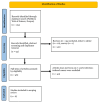Multidrug-Resistant Candida auris and its Role in Carcinogenesis: A Scoping Review
- PMID: 40417192
- PMCID: PMC12097152
- DOI: 10.21315/mjms-09-2024-691
Multidrug-Resistant Candida auris and its Role in Carcinogenesis: A Scoping Review
Abstract
Candida auris was listed as a critical fungal priority group pathogen by the World Health Organization (WHO) in 2022. It has become a leading cause of invasive candidiasis in serious nosocomial infections globally. While Candida species, particularly C. albicans, are linked to cancer development, the role of C. auris in carcinogenesis remains unexplored. This scoping review aimed to evaluate the existing evidence on the role of C. auris infection in carcinogenesis and its associated risk factors. Following the PRISMA-ScR guidelines, a comprehensive search of three databases was conducted from January 2003 to January 2024 to identify studies addressing the role of C. auris infection in cancer development and its associated risk factors. A total of 124 articles were identified, of which six met the inclusion criteria. These studies reported the risk factors associated with C. auris infection in cancer patients. The findings showed an increased susceptibility of cancer patients to C. auris infections. However, to date, no direct relationship has been reported between C. auris infection and cancer development due to the limited accuracy of diagnostic tools. In conclusion, C. auris infections increase the susceptibility of cancer patients but are not directly involved in carcinogenesis, indicating the urgency for an accurate diagnostic tool for C. auris detection and specialised infection-control measures for cancer patients.
Keywords: Candida auris; cancer; carcinogenesis; multidrug resistance; nosocomial infection; risk factors.
© Penerbit Universiti Sains Malaysia, 2025.
Conflict of interest statement
Conflicts of Interest: None.
Figures
Similar articles
-
Investigation of multi-drug resistant Candida auris using species-specific molecular markers in immunocompromised patients from a tertiary care hospital in Quetta, Pakistan.PLoS One. 2025 Apr 24;20(4):e0319485. doi: 10.1371/journal.pone.0319485. eCollection 2025. PLoS One. 2025. PMID: 40273190 Free PMC article.
-
Comparative Evaluations of the Pathogenesis of Candida auris Phenotypes and Candida albicans Using Clinically Relevant Murine Models of Infections.mSphere. 2020 Aug 5;5(4):e00760-20. doi: 10.1128/mSphere.00760-20. mSphere. 2020. PMID: 32759340 Free PMC article.
-
Candida auris-the growing menace to global health.Mycoses. 2019 Aug;62(8):620-637. doi: 10.1111/myc.12904. Epub 2019 Jun 18. Mycoses. 2019. PMID: 30773703 Review.
-
The Gcn5 lysine acetyltransferase mediates cell wall remodeling, antifungal drug resistance, and virulence of Candida auris.mSphere. 2025 Apr 29;10(4):e0006925. doi: 10.1128/msphere.00069-25. Epub 2025 Mar 11. mSphere. 2025. PMID: 40066990 Free PMC article.
-
Candida auris: An emerging multidrug-resistant pathogen.Int J Infect Dis. 2017 Oct;63:95-98. doi: 10.1016/j.ijid.2017.08.017. Epub 2017 Sep 6. Int J Infect Dis. 2017. PMID: 28888662 Review.
References
-
- WHO Antimicrobial Resistance Division (AMR) WHO fungal priority pathogens list to guide research, development and public health action [Internet] Geneva: World Health Organization; 2022. [Retrieved 2024 Aug 12]. Available at: https://www.who.int/publications/i/item/9789240060241.
Publication types
LinkOut - more resources
Full Text Sources
Miscellaneous


